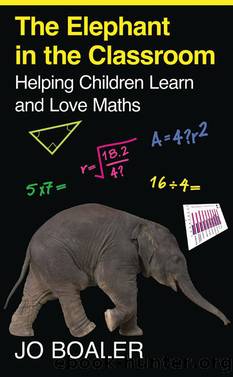The Elephant in the Classroom by Jo Boaler

Author:Jo Boaler
Language: eng
Format: epub
ISBN: 9780285639584
Publisher: Souvenir Press
Published: 2011-01-31T16:00:00+00:00
It was unfortunate for Kristina that mathematics was not one of her school subjects that allowed her to âexploreâ or to consider phenomena, when it should have been.
David Sela, from the ministry of education in Israel, and Anat Zohar from the Hebrew University in Jerusalem, conducted an extensive investigation of gender differences in the learning of physics2. They took my notion of the âquest for understandingâ that I had found to be prevalent among girls in maths classes and considered whether it was also prevalent among girls in physics classes. They found, resoundingly, that it was. The researchers drew from a database of approximately 400 high schools in Israel that offered advanced placement physics classes. They sampled 50 students from the schools and interviewed 25 girls and 25 boys. They found that the girls in physics classes were exhibiting the same preferences that I had found in mathematics classes, resisting the requirement to memorize without understanding, saying that it was âdriving them nutsâ. The girls talked about wanting to know why methods worked and how they were linked. The authors concluded that âalthough both girls and boys in the advanced placement physics classes share a quest for understanding, girls strive for it much more urgently than boys, and seem to suffer academically more than boys do in a classroom culture that does not value it.â3. Neither the female maths students I interviewed nor the female physics students interviewed in Israel wanted an easier science or maths, they did not need or want softer versions of the subjects, in fact the versions of mathematics and science they wanted required considerable depth of thought. In both cases the girls wanted opportunities to inquire deeply, and they were averse to versions of the subjects that emphasized rote learning. This was true of boys and girls but when girls were denied access to a deep, connected understanding, they turned away from the subject.
The differences that have been found between girls and boys in mathematics and physics classes do not suggest that all girls behave in one way and all boys in another. Indeed Zohar and Sela found that one third of the boys they interviewed also expressed strong preferences for a deep, connected understanding. But they, like I, found that girls consistently expressed such preferences in higher numbers and with more intensity. Such gender differences are interesting and, until recently, have been somewhat puzzling.
The idea that girls and women value a different type of knowing was famously proposed by Carol Gilligan, an internationally acclaimed psychologist and author. In Gilliganâs book In a Different Voice she claimed that women are likely to be âconnected thinkersâ, preferring to use intuition, creativity, and personal experience when making moral judgments. Men, she proposed, are more likely to be âseparateâ thinkers, preferring to use logic, rigour, absolute truth and rationality when making moral decisions.4 Gilliganâs work met a lot of resistance but it also received support from women who identified with the thinking styles she described. Some years later
Download
This site does not store any files on its server. We only index and link to content provided by other sites. Please contact the content providers to delete copyright contents if any and email us, we'll remove relevant links or contents immediately.
The Art of Coaching Workbook by Elena Aguilar(50963)
Trainspotting by Irvine Welsh(21517)
Twilight of the Idols With the Antichrist and Ecce Homo by Friedrich Nietzsche(18501)
Fangirl by Rainbow Rowell(9093)
Periodization Training for Sports by Tudor Bompa(8168)
Change Your Questions, Change Your Life by Marilee Adams(7633)
This Is How You Lose Her by Junot Diaz(6778)
Asking the Right Questions: A Guide to Critical Thinking by M. Neil Browne & Stuart M. Keeley(5630)
Grit by Angela Duckworth(5512)
Red Sparrow by Jason Matthews(5390)
Paper Towns by Green John(5086)
Room 212 by Kate Stewart(5035)
Ken Follett - World without end by Ken Follett(4643)
Housekeeping by Marilynne Robinson(4328)
The Sports Rules Book by Human Kinetics(4288)
Double Down (Diary of a Wimpy Kid Book 11) by Jeff Kinney(4204)
Papillon (English) by Henri Charrière(4195)
The Motorcycle Diaries by Ernesto Che Guevara(4009)
Exercise Technique Manual for Resistance Training by National Strength & Conditioning Association(3955)
